Exploring Theories, Principles, and Models in Education and Training
VerifiedAdded on 2022/11/25
|30
|7285
|292
Report
AI Summary
This report provides a detailed examination of various theories, principles, and models within the context of education and training. It begins by analyzing learning theories such as behaviorism, cognitivism, social constructivism, and connectivism, and discusses their practical applications in teaching, learning, and assessment. The report also explores different models of learning preferences, including the VAK model and Honey & Mumford's learning styles. Furthermore, it delves into theories, principles, and models of communication, assessment, and curriculum development, highlighting their relevance and applicability in educational settings. The analysis covers the applicability of these models in assessing learning and in curriculum design. Finally, it examines theories and models of reflection and evaluation, and how these can be applied to review and improve educational practices. The report offers valuable insights into how educators can leverage these frameworks to enhance their teaching methods and create more effective learning environments.
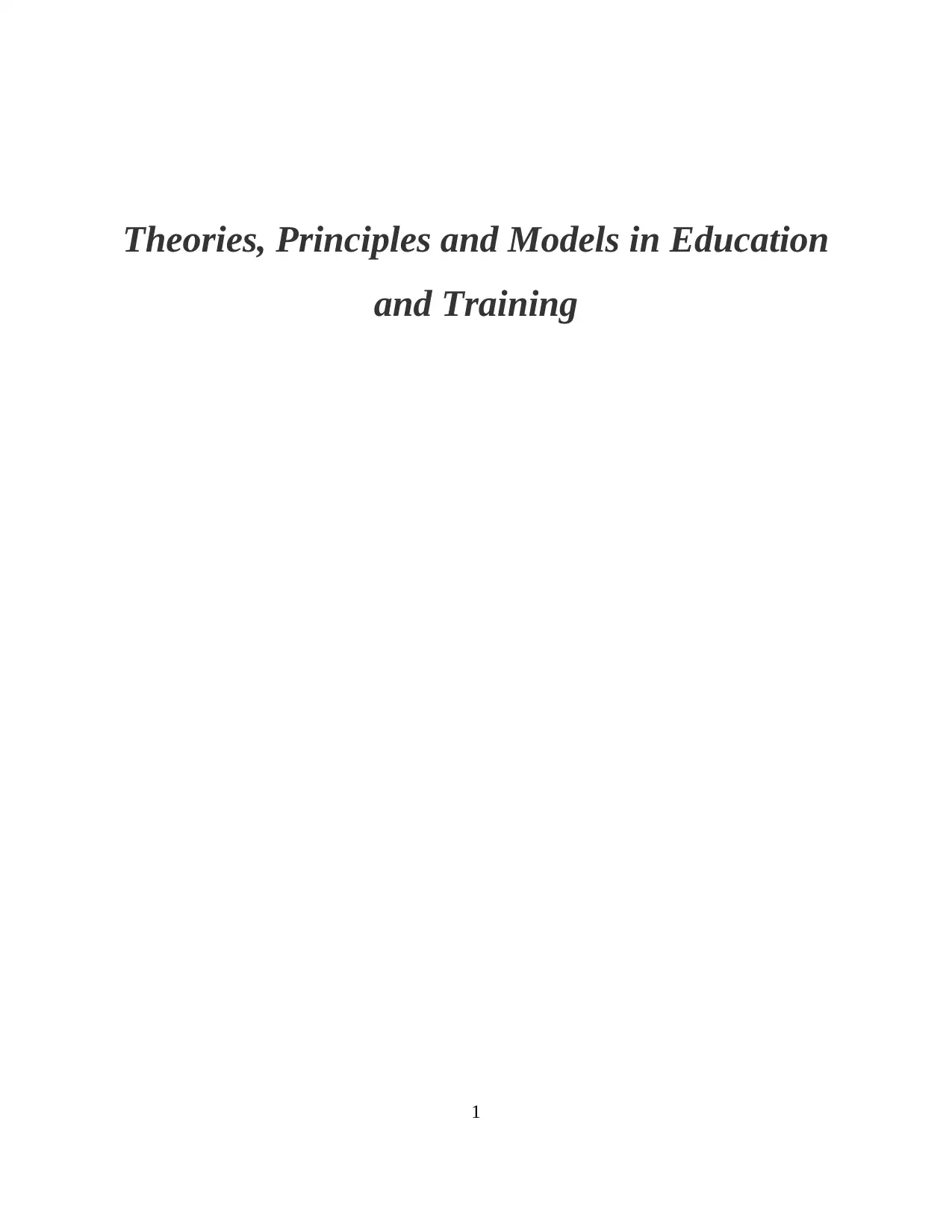
Theories, Principles and Models in Education
and Training
1
and Training
1
Paraphrase This Document
Need a fresh take? Get an instant paraphrase of this document with our AI Paraphraser
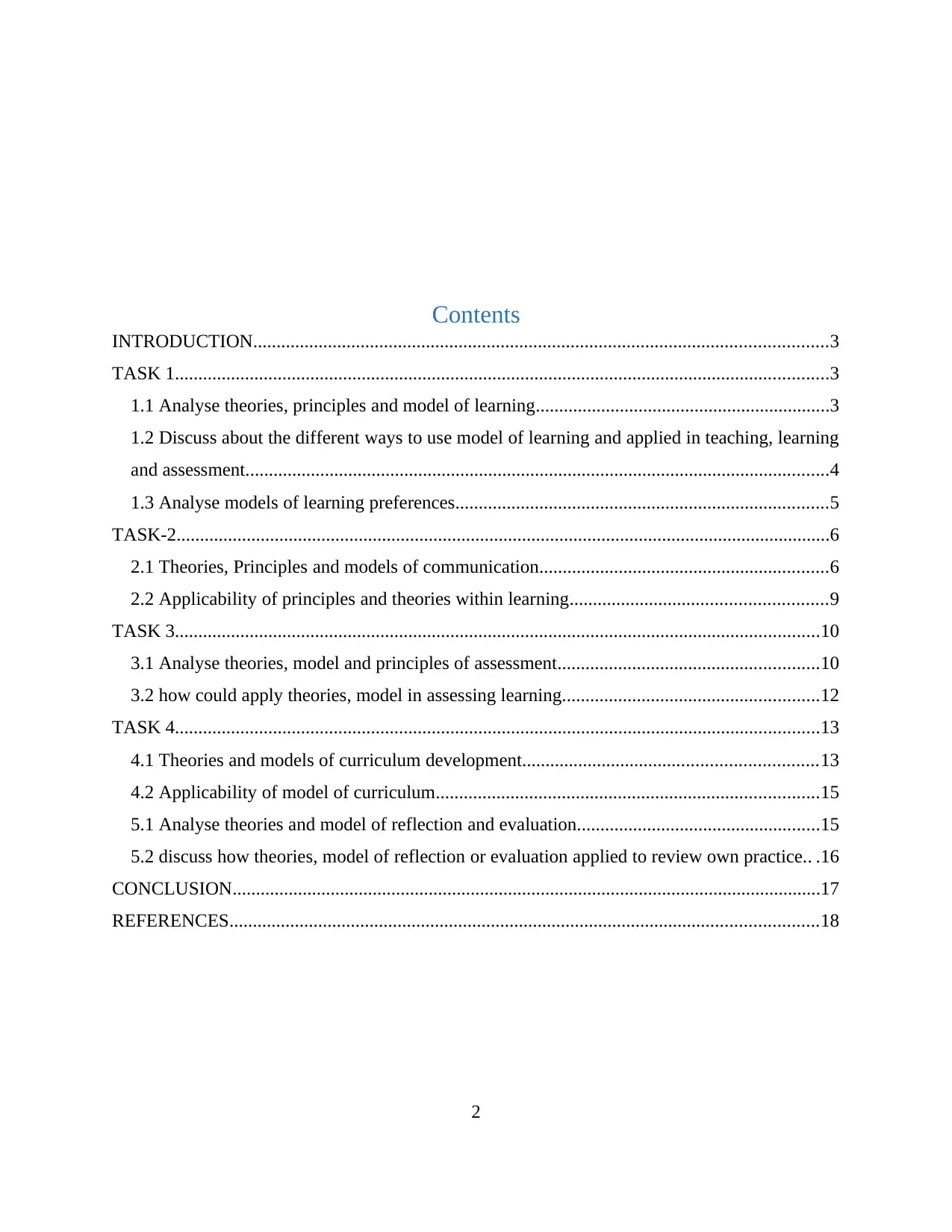
Contents
INTRODUCTION...........................................................................................................................3
TASK 1............................................................................................................................................3
1.1 Analyse theories, principles and model of learning...............................................................3
1.2 Discuss about the different ways to use model of learning and applied in teaching, learning
and assessment.............................................................................................................................4
1.3 Analyse models of learning preferences................................................................................5
TASK-2............................................................................................................................................6
2.1 Theories, Principles and models of communication..............................................................6
2.2 Applicability of principles and theories within learning.......................................................9
TASK 3..........................................................................................................................................10
3.1 Analyse theories, model and principles of assessment........................................................10
3.2 how could apply theories, model in assessing learning.......................................................12
TASK 4..........................................................................................................................................13
4.1 Theories and models of curriculum development...............................................................13
4.2 Applicability of model of curriculum..................................................................................15
5.1 Analyse theories and model of reflection and evaluation....................................................15
5.2 discuss how theories, model of reflection or evaluation applied to review own practice.. .16
CONCLUSION..............................................................................................................................17
REFERENCES..............................................................................................................................18
2
INTRODUCTION...........................................................................................................................3
TASK 1............................................................................................................................................3
1.1 Analyse theories, principles and model of learning...............................................................3
1.2 Discuss about the different ways to use model of learning and applied in teaching, learning
and assessment.............................................................................................................................4
1.3 Analyse models of learning preferences................................................................................5
TASK-2............................................................................................................................................6
2.1 Theories, Principles and models of communication..............................................................6
2.2 Applicability of principles and theories within learning.......................................................9
TASK 3..........................................................................................................................................10
3.1 Analyse theories, model and principles of assessment........................................................10
3.2 how could apply theories, model in assessing learning.......................................................12
TASK 4..........................................................................................................................................13
4.1 Theories and models of curriculum development...............................................................13
4.2 Applicability of model of curriculum..................................................................................15
5.1 Analyse theories and model of reflection and evaluation....................................................15
5.2 discuss how theories, model of reflection or evaluation applied to review own practice.. .16
CONCLUSION..............................................................................................................................17
REFERENCES..............................................................................................................................18
2
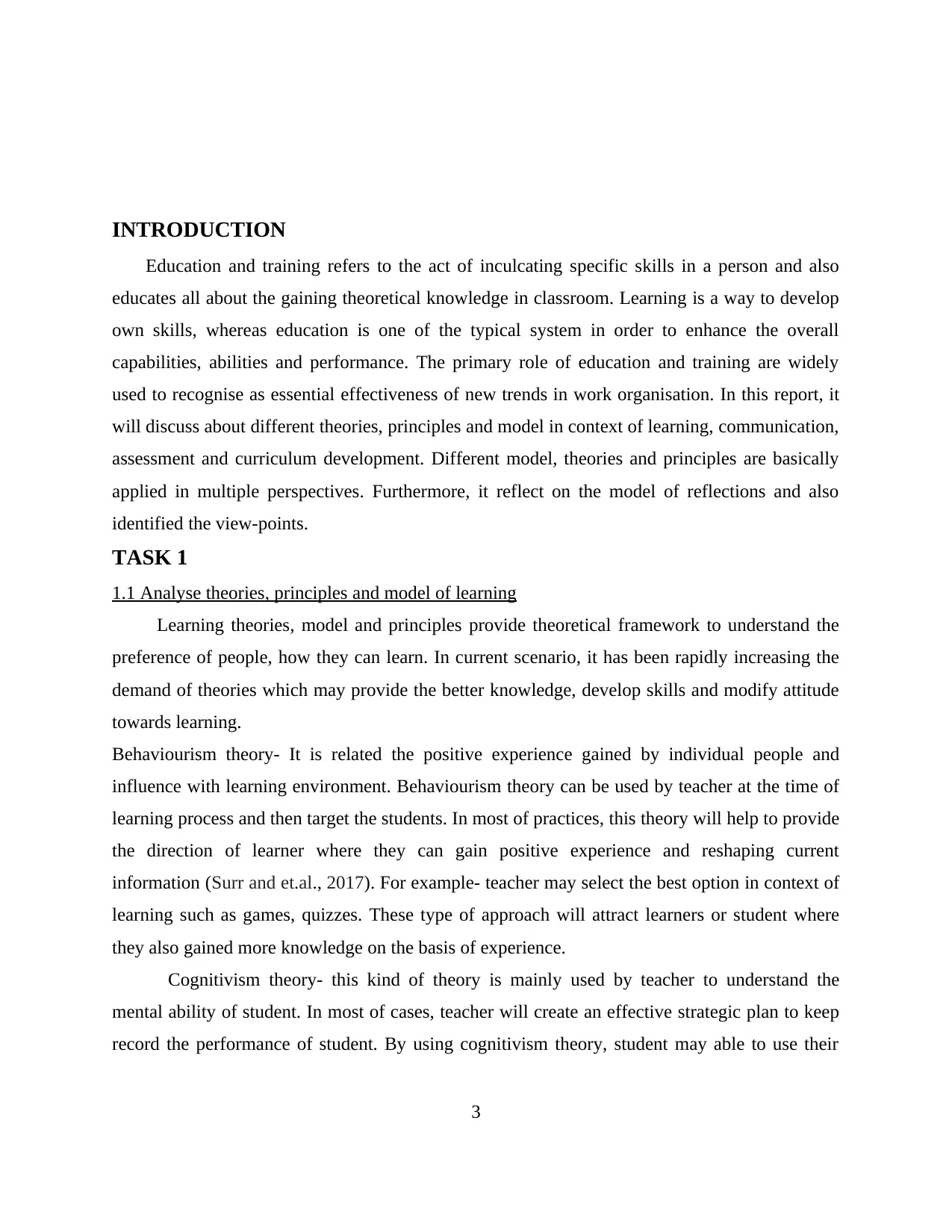
INTRODUCTION
Education and training refers to the act of inculcating specific skills in a person and also
educates all about the gaining theoretical knowledge in classroom. Learning is a way to develop
own skills, whereas education is one of the typical system in order to enhance the overall
capabilities, abilities and performance. The primary role of education and training are widely
used to recognise as essential effectiveness of new trends in work organisation. In this report, it
will discuss about different theories, principles and model in context of learning, communication,
assessment and curriculum development. Different model, theories and principles are basically
applied in multiple perspectives. Furthermore, it reflect on the model of reflections and also
identified the view-points.
TASK 1
1.1 Analyse theories, principles and model of learning
Learning theories, model and principles provide theoretical framework to understand the
preference of people, how they can learn. In current scenario, it has been rapidly increasing the
demand of theories which may provide the better knowledge, develop skills and modify attitude
towards learning.
Behaviourism theory- It is related the positive experience gained by individual people and
influence with learning environment. Behaviourism theory can be used by teacher at the time of
learning process and then target the students. In most of practices, this theory will help to provide
the direction of learner where they can gain positive experience and reshaping current
information (Surr and et.al., 2017). For example- teacher may select the best option in context of
learning such as games, quizzes. These type of approach will attract learners or student where
they also gained more knowledge on the basis of experience.
Cognitivism theory- this kind of theory is mainly used by teacher to understand the
mental ability of student. In most of cases, teacher will create an effective strategic plan to keep
record the performance of student. By using cognitivism theory, student may able to use their
3
Education and training refers to the act of inculcating specific skills in a person and also
educates all about the gaining theoretical knowledge in classroom. Learning is a way to develop
own skills, whereas education is one of the typical system in order to enhance the overall
capabilities, abilities and performance. The primary role of education and training are widely
used to recognise as essential effectiveness of new trends in work organisation. In this report, it
will discuss about different theories, principles and model in context of learning, communication,
assessment and curriculum development. Different model, theories and principles are basically
applied in multiple perspectives. Furthermore, it reflect on the model of reflections and also
identified the view-points.
TASK 1
1.1 Analyse theories, principles and model of learning
Learning theories, model and principles provide theoretical framework to understand the
preference of people, how they can learn. In current scenario, it has been rapidly increasing the
demand of theories which may provide the better knowledge, develop skills and modify attitude
towards learning.
Behaviourism theory- It is related the positive experience gained by individual people and
influence with learning environment. Behaviourism theory can be used by teacher at the time of
learning process and then target the students. In most of practices, this theory will help to provide
the direction of learner where they can gain positive experience and reshaping current
information (Surr and et.al., 2017). For example- teacher may select the best option in context of
learning such as games, quizzes. These type of approach will attract learners or student where
they also gained more knowledge on the basis of experience.
Cognitivism theory- this kind of theory is mainly used by teacher to understand the
mental ability of student. In most of cases, teacher will create an effective strategic plan to keep
record the performance of student. By using cognitivism theory, student may able to use their
3
⊘ This is a preview!⊘
Do you want full access?
Subscribe today to unlock all pages.

Trusted by 1+ million students worldwide
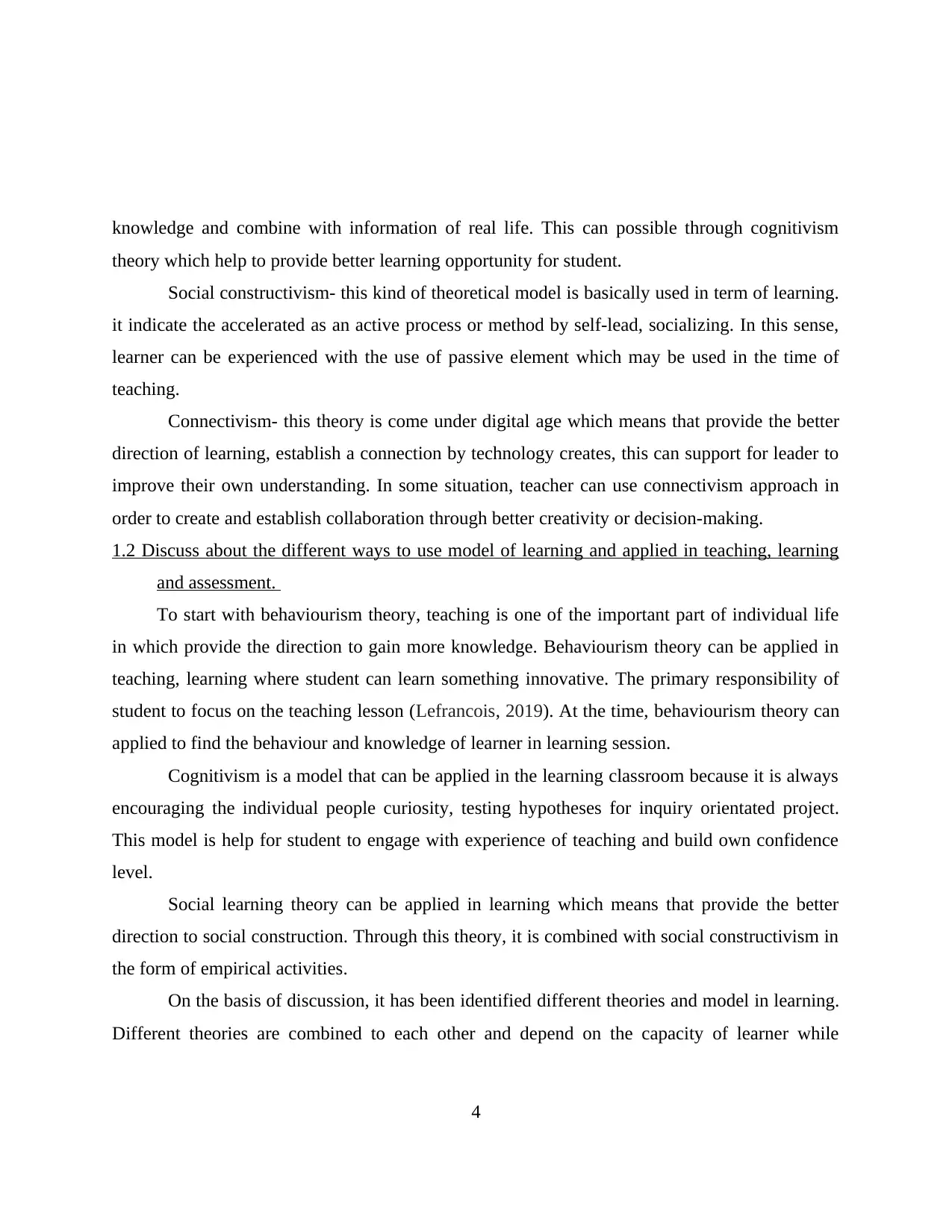
knowledge and combine with information of real life. This can possible through cognitivism
theory which help to provide better learning opportunity for student.
Social constructivism- this kind of theoretical model is basically used in term of learning.
it indicate the accelerated as an active process or method by self-lead, socializing. In this sense,
learner can be experienced with the use of passive element which may be used in the time of
teaching.
Connectivism- this theory is come under digital age which means that provide the better
direction of learning, establish a connection by technology creates, this can support for leader to
improve their own understanding. In some situation, teacher can use connectivism approach in
order to create and establish collaboration through better creativity or decision-making.
1.2 Discuss about the different ways to use model of learning and applied in teaching, learning
and assessment.
To start with behaviourism theory, teaching is one of the important part of individual life
in which provide the direction to gain more knowledge. Behaviourism theory can be applied in
teaching, learning where student can learn something innovative. The primary responsibility of
student to focus on the teaching lesson (Lefrancois, 2019). At the time, behaviourism theory can
applied to find the behaviour and knowledge of learner in learning session.
Cognitivism is a model that can be applied in the learning classroom because it is always
encouraging the individual people curiosity, testing hypotheses for inquiry orientated project.
This model is help for student to engage with experience of teaching and build own confidence
level.
Social learning theory can be applied in learning which means that provide the better
direction to social construction. Through this theory, it is combined with social constructivism in
the form of empirical activities.
On the basis of discussion, it has been identified different theories and model in learning.
Different theories are combined to each other and depend on the capacity of learner while
4
theory which help to provide better learning opportunity for student.
Social constructivism- this kind of theoretical model is basically used in term of learning.
it indicate the accelerated as an active process or method by self-lead, socializing. In this sense,
learner can be experienced with the use of passive element which may be used in the time of
teaching.
Connectivism- this theory is come under digital age which means that provide the better
direction of learning, establish a connection by technology creates, this can support for leader to
improve their own understanding. In some situation, teacher can use connectivism approach in
order to create and establish collaboration through better creativity or decision-making.
1.2 Discuss about the different ways to use model of learning and applied in teaching, learning
and assessment.
To start with behaviourism theory, teaching is one of the important part of individual life
in which provide the direction to gain more knowledge. Behaviourism theory can be applied in
teaching, learning where student can learn something innovative. The primary responsibility of
student to focus on the teaching lesson (Lefrancois, 2019). At the time, behaviourism theory can
applied to find the behaviour and knowledge of learner in learning session.
Cognitivism is a model that can be applied in the learning classroom because it is always
encouraging the individual people curiosity, testing hypotheses for inquiry orientated project.
This model is help for student to engage with experience of teaching and build own confidence
level.
Social learning theory can be applied in learning which means that provide the better
direction to social construction. Through this theory, it is combined with social constructivism in
the form of empirical activities.
On the basis of discussion, it has been identified different theories and model in learning.
Different theories are combined to each other and depend on the capacity of learner while
4
Paraphrase This Document
Need a fresh take? Get an instant paraphrase of this document with our AI Paraphraser
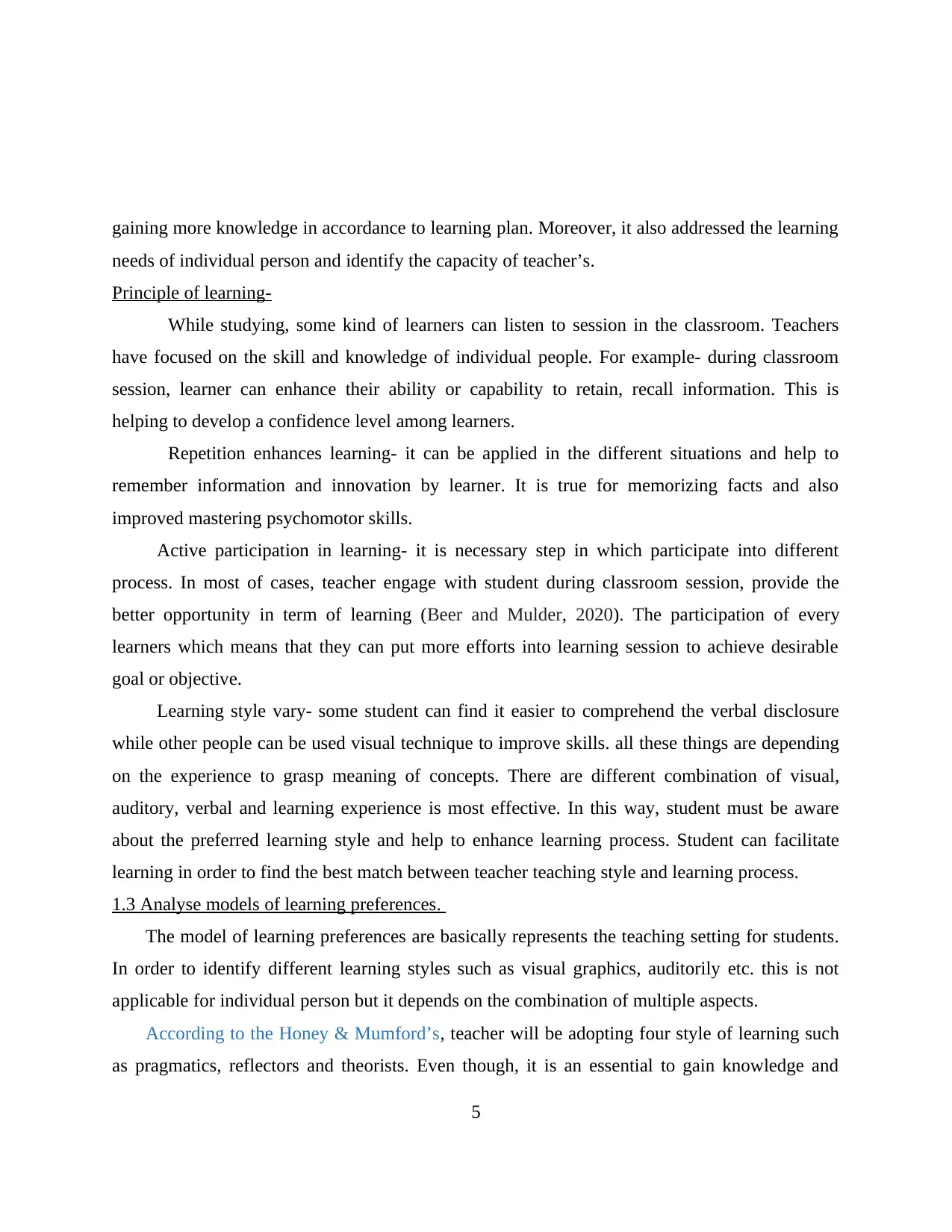
gaining more knowledge in accordance to learning plan. Moreover, it also addressed the learning
needs of individual person and identify the capacity of teacher’s.
Principle of learning-
While studying, some kind of learners can listen to session in the classroom. Teachers
have focused on the skill and knowledge of individual people. For example- during classroom
session, learner can enhance their ability or capability to retain, recall information. This is
helping to develop a confidence level among learners.
Repetition enhances learning- it can be applied in the different situations and help to
remember information and innovation by learner. It is true for memorizing facts and also
improved mastering psychomotor skills.
Active participation in learning- it is necessary step in which participate into different
process. In most of cases, teacher engage with student during classroom session, provide the
better opportunity in term of learning (Beer and Mulder, 2020). The participation of every
learners which means that they can put more efforts into learning session to achieve desirable
goal or objective.
Learning style vary- some student can find it easier to comprehend the verbal disclosure
while other people can be used visual technique to improve skills. all these things are depending
on the experience to grasp meaning of concepts. There are different combination of visual,
auditory, verbal and learning experience is most effective. In this way, student must be aware
about the preferred learning style and help to enhance learning process. Student can facilitate
learning in order to find the best match between teacher teaching style and learning process.
1.3 Analyse models of learning preferences.
The model of learning preferences are basically represents the teaching setting for students.
In order to identify different learning styles such as visual graphics, auditorily etc. this is not
applicable for individual person but it depends on the combination of multiple aspects.
According to the Honey & Mumford’s, teacher will be adopting four style of learning such
as pragmatics, reflectors and theorists. Even though, it is an essential to gain knowledge and
5
needs of individual person and identify the capacity of teacher’s.
Principle of learning-
While studying, some kind of learners can listen to session in the classroom. Teachers
have focused on the skill and knowledge of individual people. For example- during classroom
session, learner can enhance their ability or capability to retain, recall information. This is
helping to develop a confidence level among learners.
Repetition enhances learning- it can be applied in the different situations and help to
remember information and innovation by learner. It is true for memorizing facts and also
improved mastering psychomotor skills.
Active participation in learning- it is necessary step in which participate into different
process. In most of cases, teacher engage with student during classroom session, provide the
better opportunity in term of learning (Beer and Mulder, 2020). The participation of every
learners which means that they can put more efforts into learning session to achieve desirable
goal or objective.
Learning style vary- some student can find it easier to comprehend the verbal disclosure
while other people can be used visual technique to improve skills. all these things are depending
on the experience to grasp meaning of concepts. There are different combination of visual,
auditory, verbal and learning experience is most effective. In this way, student must be aware
about the preferred learning style and help to enhance learning process. Student can facilitate
learning in order to find the best match between teacher teaching style and learning process.
1.3 Analyse models of learning preferences.
The model of learning preferences are basically represents the teaching setting for students.
In order to identify different learning styles such as visual graphics, auditorily etc. this is not
applicable for individual person but it depends on the combination of multiple aspects.
According to the Honey & Mumford’s, teacher will be adopting four style of learning such
as pragmatics, reflectors and theorists. Even though, it is an essential to gain knowledge and
5
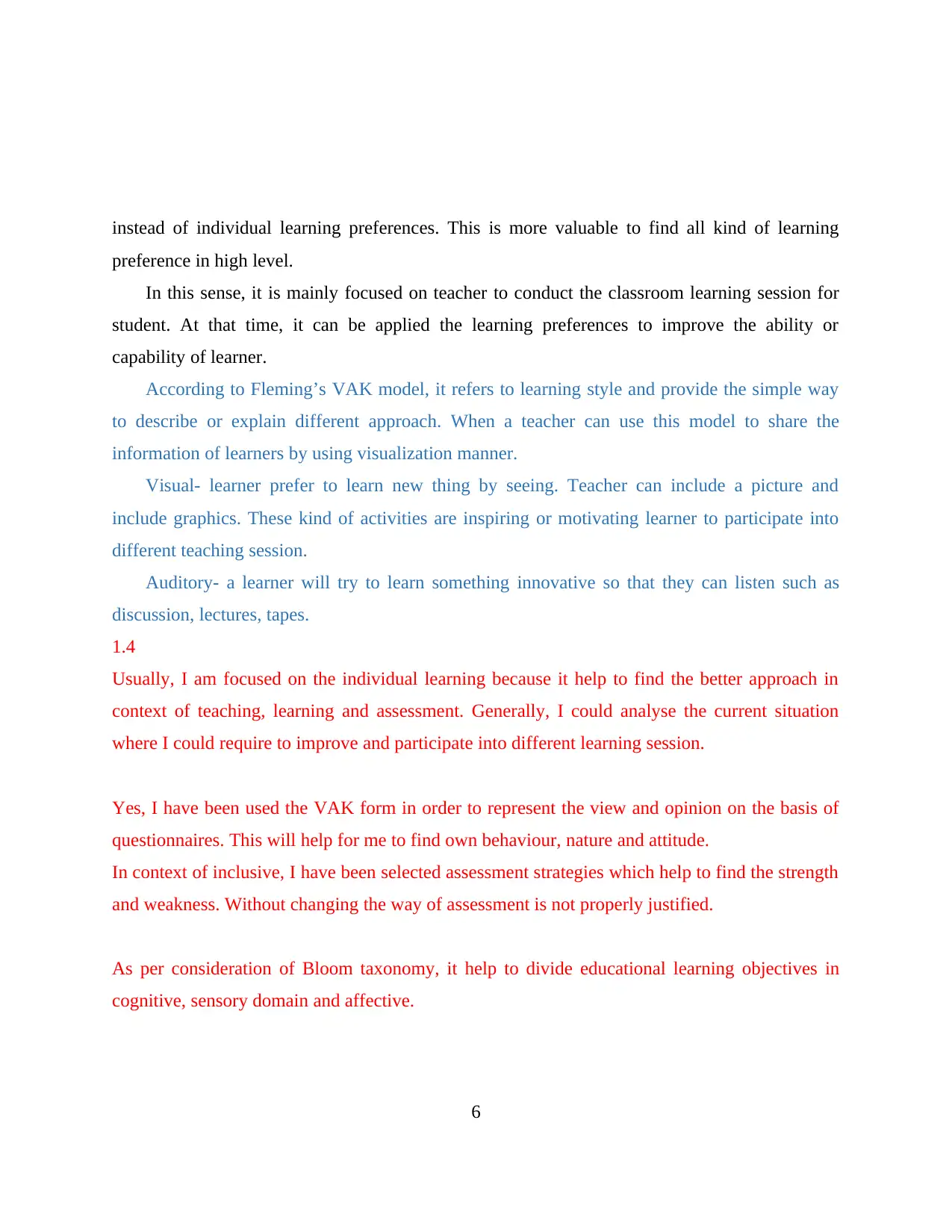
instead of individual learning preferences. This is more valuable to find all kind of learning
preference in high level.
In this sense, it is mainly focused on teacher to conduct the classroom learning session for
student. At that time, it can be applied the learning preferences to improve the ability or
capability of learner.
According to Fleming’s VAK model, it refers to learning style and provide the simple way
to describe or explain different approach. When a teacher can use this model to share the
information of learners by using visualization manner.
Visual- learner prefer to learn new thing by seeing. Teacher can include a picture and
include graphics. These kind of activities are inspiring or motivating learner to participate into
different teaching session.
Auditory- a learner will try to learn something innovative so that they can listen such as
discussion, lectures, tapes.
1.4
Usually, I am focused on the individual learning because it help to find the better approach in
context of teaching, learning and assessment. Generally, I could analyse the current situation
where I could require to improve and participate into different learning session.
Yes, I have been used the VAK form in order to represent the view and opinion on the basis of
questionnaires. This will help for me to find own behaviour, nature and attitude.
In context of inclusive, I have been selected assessment strategies which help to find the strength
and weakness. Without changing the way of assessment is not properly justified.
As per consideration of Bloom taxonomy, it help to divide educational learning objectives in
cognitive, sensory domain and affective.
6
preference in high level.
In this sense, it is mainly focused on teacher to conduct the classroom learning session for
student. At that time, it can be applied the learning preferences to improve the ability or
capability of learner.
According to Fleming’s VAK model, it refers to learning style and provide the simple way
to describe or explain different approach. When a teacher can use this model to share the
information of learners by using visualization manner.
Visual- learner prefer to learn new thing by seeing. Teacher can include a picture and
include graphics. These kind of activities are inspiring or motivating learner to participate into
different teaching session.
Auditory- a learner will try to learn something innovative so that they can listen such as
discussion, lectures, tapes.
1.4
Usually, I am focused on the individual learning because it help to find the better approach in
context of teaching, learning and assessment. Generally, I could analyse the current situation
where I could require to improve and participate into different learning session.
Yes, I have been used the VAK form in order to represent the view and opinion on the basis of
questionnaires. This will help for me to find own behaviour, nature and attitude.
In context of inclusive, I have been selected assessment strategies which help to find the strength
and weakness. Without changing the way of assessment is not properly justified.
As per consideration of Bloom taxonomy, it help to divide educational learning objectives in
cognitive, sensory domain and affective.
6
⊘ This is a preview!⊘
Do you want full access?
Subscribe today to unlock all pages.

Trusted by 1+ million students worldwide
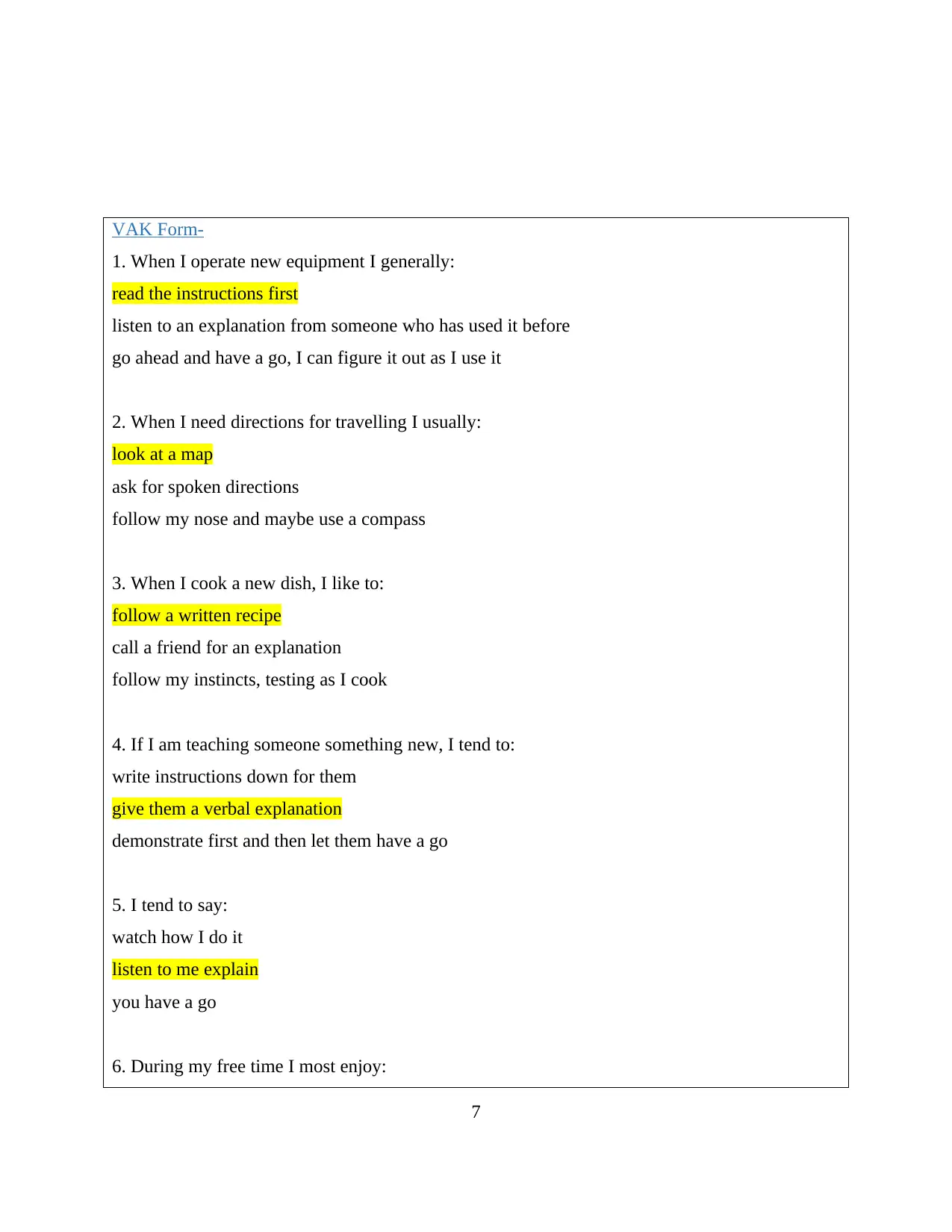
VAK Form-
1. When I operate new equipment I generally:
read the instructions first
listen to an explanation from someone who has used it before
go ahead and have a go, I can figure it out as I use it
2. When I need directions for travelling I usually:
look at a map
ask for spoken directions
follow my nose and maybe use a compass
3. When I cook a new dish, I like to:
follow a written recipe
call a friend for an explanation
follow my instincts, testing as I cook
4. If I am teaching someone something new, I tend to:
write instructions down for them
give them a verbal explanation
demonstrate first and then let them have a go
5. I tend to say:
watch how I do it
listen to me explain
you have a go
6. During my free time I most enjoy:
7
1. When I operate new equipment I generally:
read the instructions first
listen to an explanation from someone who has used it before
go ahead and have a go, I can figure it out as I use it
2. When I need directions for travelling I usually:
look at a map
ask for spoken directions
follow my nose and maybe use a compass
3. When I cook a new dish, I like to:
follow a written recipe
call a friend for an explanation
follow my instincts, testing as I cook
4. If I am teaching someone something new, I tend to:
write instructions down for them
give them a verbal explanation
demonstrate first and then let them have a go
5. I tend to say:
watch how I do it
listen to me explain
you have a go
6. During my free time I most enjoy:
7
Paraphrase This Document
Need a fresh take? Get an instant paraphrase of this document with our AI Paraphraser
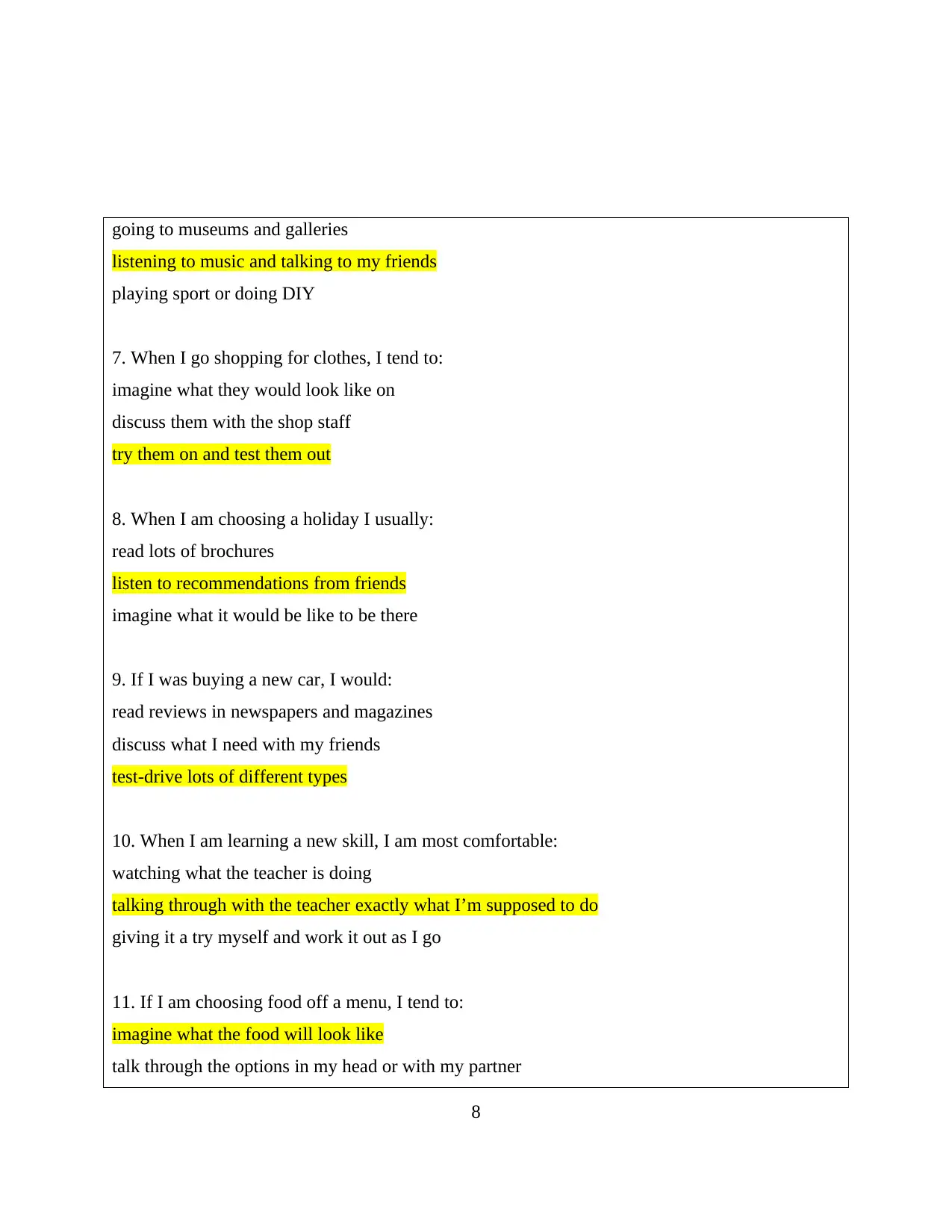
going to museums and galleries
listening to music and talking to my friends
playing sport or doing DIY
7. When I go shopping for clothes, I tend to:
imagine what they would look like on
discuss them with the shop staff
try them on and test them out
8. When I am choosing a holiday I usually:
read lots of brochures
listen to recommendations from friends
imagine what it would be like to be there
9. If I was buying a new car, I would:
read reviews in newspapers and magazines
discuss what I need with my friends
test-drive lots of different types
10. When I am learning a new skill, I am most comfortable:
watching what the teacher is doing
talking through with the teacher exactly what I’m supposed to do
giving it a try myself and work it out as I go
11. If I am choosing food off a menu, I tend to:
imagine what the food will look like
talk through the options in my head or with my partner
8
listening to music and talking to my friends
playing sport or doing DIY
7. When I go shopping for clothes, I tend to:
imagine what they would look like on
discuss them with the shop staff
try them on and test them out
8. When I am choosing a holiday I usually:
read lots of brochures
listen to recommendations from friends
imagine what it would be like to be there
9. If I was buying a new car, I would:
read reviews in newspapers and magazines
discuss what I need with my friends
test-drive lots of different types
10. When I am learning a new skill, I am most comfortable:
watching what the teacher is doing
talking through with the teacher exactly what I’m supposed to do
giving it a try myself and work it out as I go
11. If I am choosing food off a menu, I tend to:
imagine what the food will look like
talk through the options in my head or with my partner
8
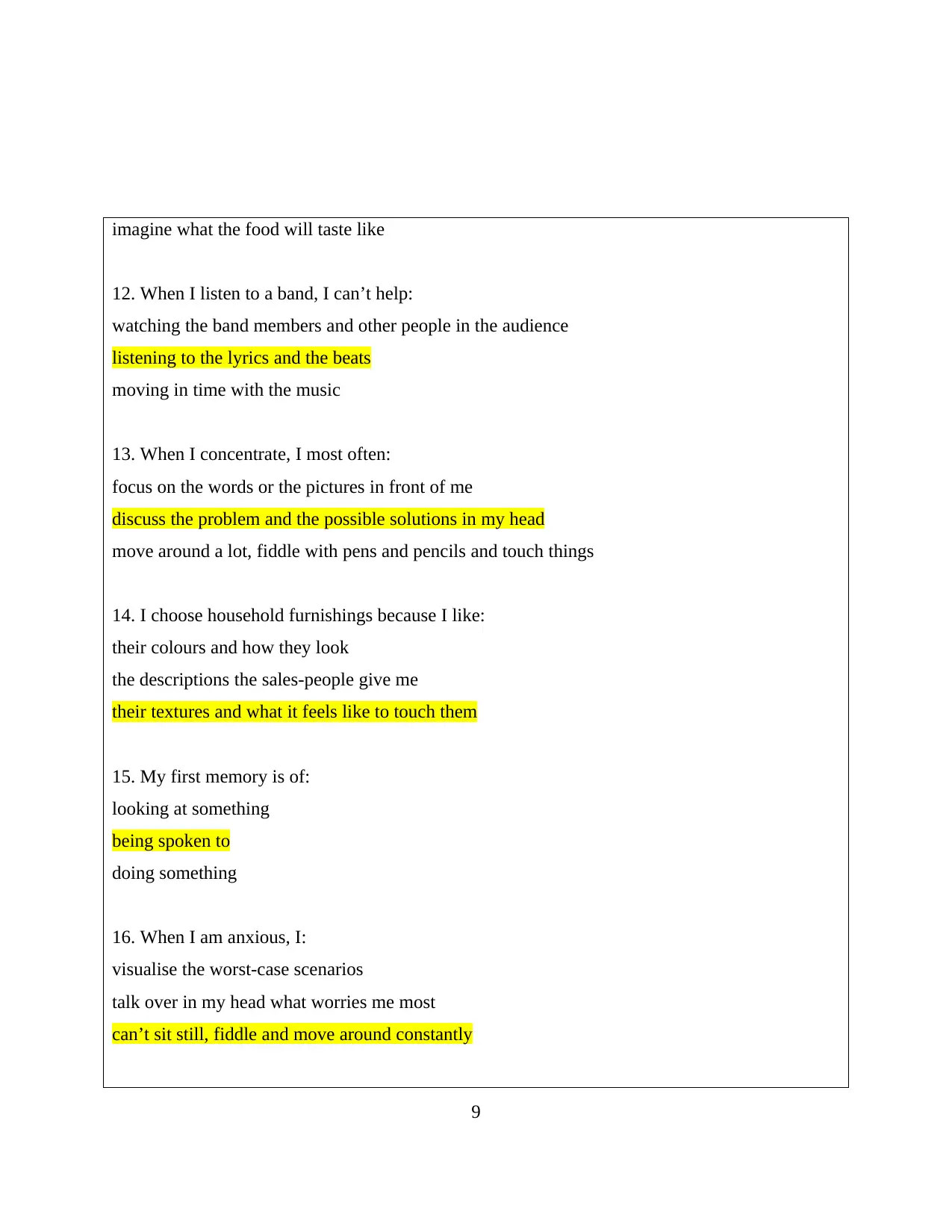
imagine what the food will taste like
12. When I listen to a band, I can’t help:
watching the band members and other people in the audience
listening to the lyrics and the beats
moving in time with the music
13. When I concentrate, I most often:
focus on the words or the pictures in front of me
discuss the problem and the possible solutions in my head
move around a lot, fiddle with pens and pencils and touch things
14. I choose household furnishings because I like:
their colours and how they look
the descriptions the sales-people give me
their textures and what it feels like to touch them
15. My first memory is of:
looking at something
being spoken to
doing something
16. When I am anxious, I:
visualise the worst-case scenarios
talk over in my head what worries me most
can’t sit still, fiddle and move around constantly
9
12. When I listen to a band, I can’t help:
watching the band members and other people in the audience
listening to the lyrics and the beats
moving in time with the music
13. When I concentrate, I most often:
focus on the words or the pictures in front of me
discuss the problem and the possible solutions in my head
move around a lot, fiddle with pens and pencils and touch things
14. I choose household furnishings because I like:
their colours and how they look
the descriptions the sales-people give me
their textures and what it feels like to touch them
15. My first memory is of:
looking at something
being spoken to
doing something
16. When I am anxious, I:
visualise the worst-case scenarios
talk over in my head what worries me most
can’t sit still, fiddle and move around constantly
9
⊘ This is a preview!⊘
Do you want full access?
Subscribe today to unlock all pages.

Trusted by 1+ million students worldwide
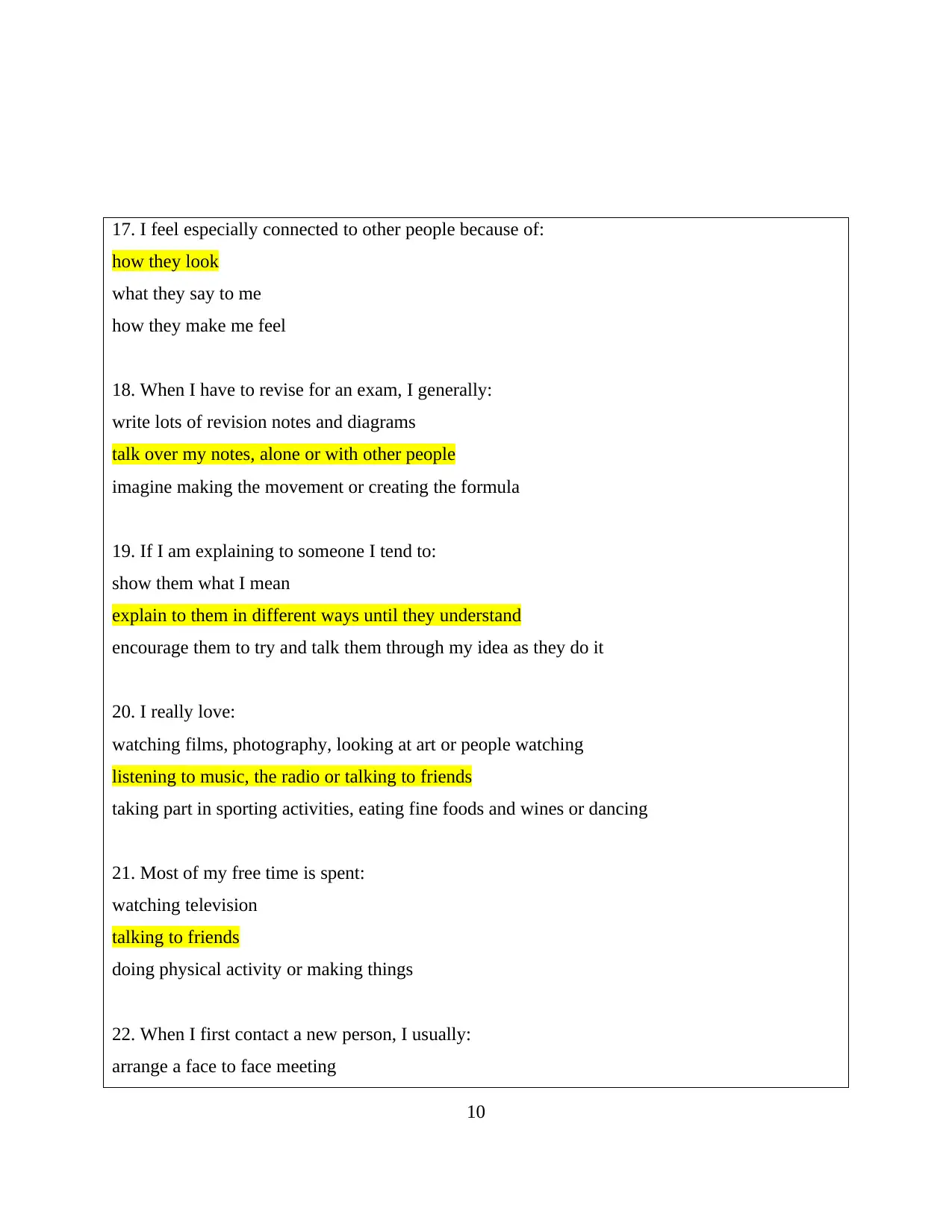
17. I feel especially connected to other people because of:
how they look
what they say to me
how they make me feel
18. When I have to revise for an exam, I generally:
write lots of revision notes and diagrams
talk over my notes, alone or with other people
imagine making the movement or creating the formula
19. If I am explaining to someone I tend to:
show them what I mean
explain to them in different ways until they understand
encourage them to try and talk them through my idea as they do it
20. I really love:
watching films, photography, looking at art or people watching
listening to music, the radio or talking to friends
taking part in sporting activities, eating fine foods and wines or dancing
21. Most of my free time is spent:
watching television
talking to friends
doing physical activity or making things
22. When I first contact a new person, I usually:
arrange a face to face meeting
10
how they look
what they say to me
how they make me feel
18. When I have to revise for an exam, I generally:
write lots of revision notes and diagrams
talk over my notes, alone or with other people
imagine making the movement or creating the formula
19. If I am explaining to someone I tend to:
show them what I mean
explain to them in different ways until they understand
encourage them to try and talk them through my idea as they do it
20. I really love:
watching films, photography, looking at art or people watching
listening to music, the radio or talking to friends
taking part in sporting activities, eating fine foods and wines or dancing
21. Most of my free time is spent:
watching television
talking to friends
doing physical activity or making things
22. When I first contact a new person, I usually:
arrange a face to face meeting
10
Paraphrase This Document
Need a fresh take? Get an instant paraphrase of this document with our AI Paraphraser

talk to them on the telephone
try to get together whilst doing something else, such as an activity or a meal
23. I first notice how people:
look and dress
sound and speak
stand and move
24. If I am angry, I tend to:
keep replaying in my mind what it is that has upset me
raise my voice and tell people how I feel
stamp about, slam doors and physically demonstrate my anger
25. I find it easiest to remember:
faces
names
things I have done
26. I think that you can tell if someone is lying if:
they avoid looking at you
their voices changes
they give me funny vibes
27. When I meet an old friend:
I say “it’s great to see you!”
I say “it’s great to hear from you!”
I give them a hug or a handshake
11
try to get together whilst doing something else, such as an activity or a meal
23. I first notice how people:
look and dress
sound and speak
stand and move
24. If I am angry, I tend to:
keep replaying in my mind what it is that has upset me
raise my voice and tell people how I feel
stamp about, slam doors and physically demonstrate my anger
25. I find it easiest to remember:
faces
names
things I have done
26. I think that you can tell if someone is lying if:
they avoid looking at you
their voices changes
they give me funny vibes
27. When I meet an old friend:
I say “it’s great to see you!”
I say “it’s great to hear from you!”
I give them a hug or a handshake
11
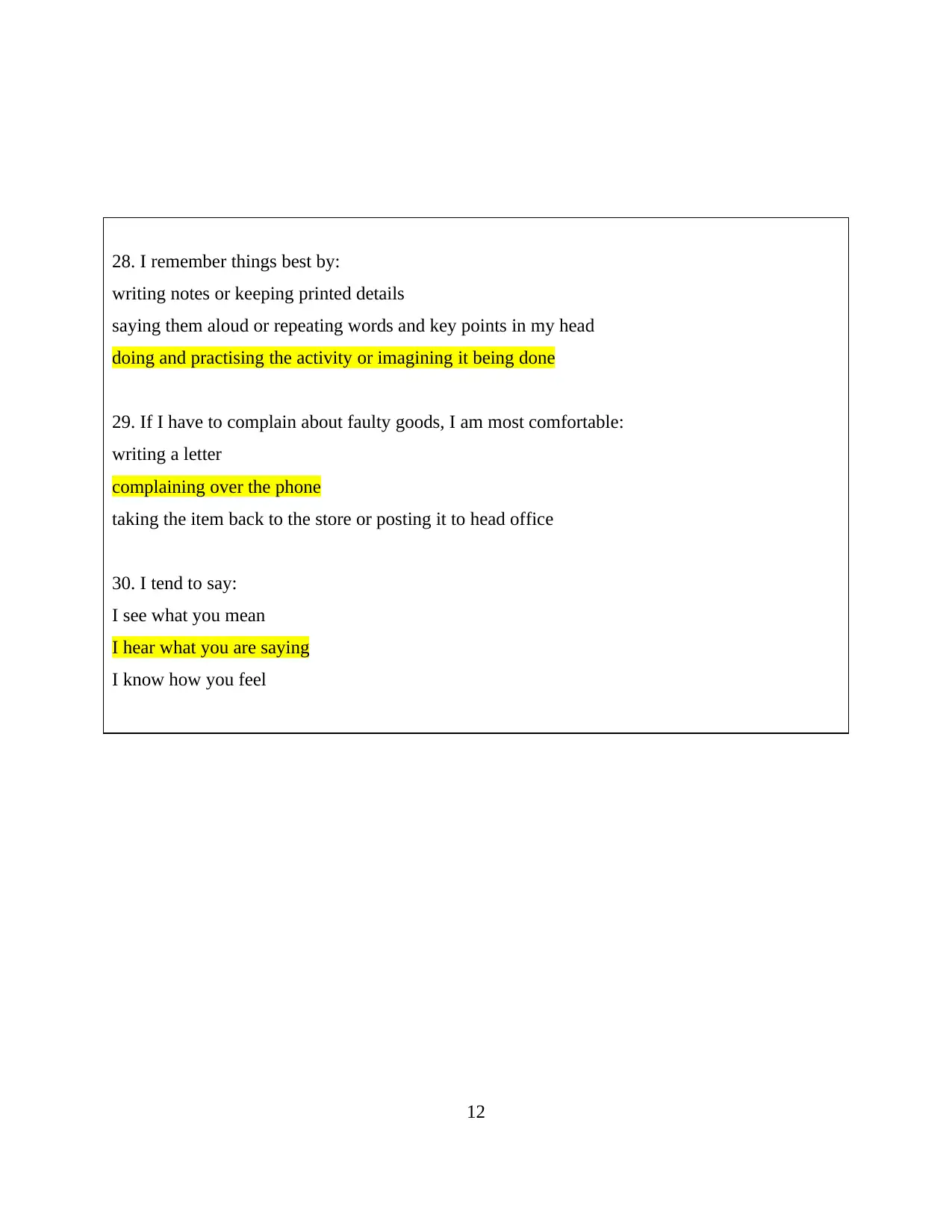
28. I remember things best by:
writing notes or keeping printed details
saying them aloud or repeating words and key points in my head
doing and practising the activity or imagining it being done
29. If I have to complain about faulty goods, I am most comfortable:
writing a letter
complaining over the phone
taking the item back to the store or posting it to head office
30. I tend to say:
I see what you mean
I hear what you are saying
I know how you feel
12
writing notes or keeping printed details
saying them aloud or repeating words and key points in my head
doing and practising the activity or imagining it being done
29. If I have to complain about faulty goods, I am most comfortable:
writing a letter
complaining over the phone
taking the item back to the store or posting it to head office
30. I tend to say:
I see what you mean
I hear what you are saying
I know how you feel
12
⊘ This is a preview!⊘
Do you want full access?
Subscribe today to unlock all pages.

Trusted by 1+ million students worldwide
1 out of 30
Related Documents
Your All-in-One AI-Powered Toolkit for Academic Success.
+13062052269
info@desklib.com
Available 24*7 on WhatsApp / Email
![[object Object]](/_next/static/media/star-bottom.7253800d.svg)
Unlock your academic potential
Copyright © 2020–2025 A2Z Services. All Rights Reserved. Developed and managed by ZUCOL.



